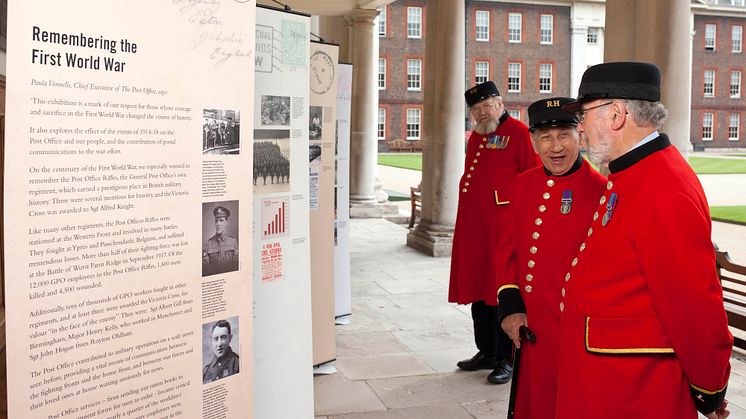
Press release -
Post Office Commemorates First World War With Nationwide Touring Displays
- Post Office launches centenary programme of events to mark 1914-18 war
- The displays honour the Post Office Rifles who served with distinction, and will appear in Post Office branches across the UK
- The exhibition pays tribute to local communities whose bravery will never be forgotten – 75,000 GPO workers fought in the War and 8,500 were killed
- Remembers crucial role of women who took over from absent fathers, husbands, brothers, and sons
‘Bullets rattled on my steel helmet – there were several significant dents and one hole – part of a book was shot away in my pocket; a photograph case and cigarette case probably saved my life from one bullet which must have passed under my armpit’ – Sergeant Alfred J Knight VC, Post Office Rifles
The Post Office today announces plans for special travelling displays in their branches to commemorate the First World War.
The exhibitions, launched at the Royal Hospital, Chelsea, home of the iconic Chelsea pensioners, will travel the length and breadth of the UK and offer a greater understanding of how the General Post Office fitted into the story of the First World War.
They will connect communities to their shared history, help people to explore their own relatives’ links to the war, and ensure that memories of the sacrifice for British freedom are kept alive.
The exhibition, curated with The British Postal Museum & Archive (BPMA), is part of a five-year programme of events by the Post Office to mark the centenary of the First World War.
The Post Office Rifles fought at Ypres, the Somme and Passchendaele and were awarded 145 decorations for gallantry, including a Victoria Cross to Sergeant Alfred J Knight from Birmingham.
At least three more GPO employees who fought in other regiments were awarded the VC, the highest medal for gallantry. They were: Sgt Albert Gill from Birmingham; Major Henry Kelly from Manchester; and Sgt John Hogan, of Royton near Oldham.
Paula Vennells, chief executive of The Post Office, said: “This exhibition is a mark of our respect for those whose courage and sacrifice in the First World War changed the course of history.
“On the centenary of the First World War, we particularly wanted to remember the Post Office Rifles, who earned high praise and a prestigious place in British military history. About 1,800 of its soldiers were killed – and 4,500 injured – during the war.
“We’re proud to honour the fallen and their families this centenary. From the heroes of the Post Office Rifles to those who serve near and far today, their courage and sacrifice will never be forgotten.”
Hilary Pillin (nee Young), whose grandfather Walter Young fought with the Post Office Rifles and was awarded the Military Medal, said: “This display is about remembering individuals - like my grandfather, and millions of others – and the extraordinary sacrifices they made. It particularly helps the next generation understand the significance of what happened during the First World War.
“The fact that my grandfather survived, despite being shot and captured, when so many of his fellow Post Office Rifles, and men serving alongside him, became casualties, still seems little short of a miracle. His humility and resilience throughout those dreadful experiences has always been an inspiration to me even though, sadly, I never got to meet him.”
Walter Young served with the Post Office Rifles (47th Division, 8th London Regiment) from March 1915 until captured by the Germans in 1918. His job was to run out through barbed wire into no man’s land and rescue wounded soldiers from shell holes while under heavy fire at Bullecourt, France. When he was eventually shot through his helmet – the bullet missed his head - he was captured and sent to work in a Prussian coal mine. When the war ended, he resumed his job at the GPO. His compelling story of suffering and survival has only recently emerged in previously unpublished diaries.
Issued by: Post Office Press Office
1st Floor, 148 Old Street, LONDON
EC1V 9HQ
Tel: 07435 769020/020 7012 3456
Email: pressoffice@postoffice.co.uk
Twitter: @PostOfficeNews
www.postoffice.co.uk
The GPO’s involvement in the First World War
The GPO comprised of the Post Office, Royal Mail and BT.
Post Office and Royal Mail are now separate companies with independent Boards.
The Post Office has worked closely with the BPMA commemorating the First World War.
At least four former members of GPO staff will be included in nationwide tributes to those awarded the VC, the highest and most prestigious award for gallantry.
They are: Sgt Albert Gill, a GPO employee from Birmingham, who was killed in action in 1916 when he faced down the enemy, despite knowing it meant certain death, to hold up an advance
Birmingham-born Sgt Alfred Knight, a GPO employee who later worked in Nottingham, single-handedly captured an enemy position during the Battle for Wurst Farm Ridge in 1917. Knight survived the war
Major Henry Kelly, who worked for the GPO at a sorting office in Manchester at the outbreak of war; he was awarded the VC after conspicuous bravery during an attack in Le Sars, France when under heavy fire he led three men into an enemy trench, and then, when forced to retreat when enemy reinforcements arrived, carried his wounded Company Sergeant Major to safety. Major Kelly continued to work for the GPO after the war
Sgt John Hogan, a postman from Royton near Oldham, was 30 years old, and a sergeant in the 2nd Battalion, The Manchester Regiment, British Army during the First World War. He was awarded the Victoria Cross for great courage under fire on 29 October 1914 near Festubert, France.
The Post Office Rifles
Today Post Office Rifles are best remembered for their involvement as infantry on the Western Front in the First World War. Their bravery, tenacity and character during the severe circumstances of the trenches are well-documented and their endeavours on the Somme, Passchendaele, and elsewhere have earned the regiment high praise and a prestigious place in British military history.
Comprised mostly of Post Office employees, approximately 12,000 men fought with the regiment, suffering losses of 1,800 and 4,500 wounded.
The Post Office Rifles fought at Ypres and at Passchendaele and suffered tremendous losses. More than half of their fighting force was lost at the Battle of Wurst Farm Ridge in September 1917.
Although unique in its composition, the experiences of the PORs were entirely representative of life on the Western Front. The 1st Battalion embarked from Southampton on 17 March 1915 and after a period of training and acclimatisation, entered the trenches to fight in the battle for Festubert, France on 11 May that year.
The Post Office Rifles fought resiliently to secure and reinforce the British position there but the experience was traumatic.
Loos and the Somme
The regiment saw further action at Loos in the same year and in 1916, POR battalions were involved in some of the worst carnage of the war at the Battle of the Somme. For their part, the PORs entered the hostilities late in the battle (October) but still sustained 40 dead, 160 wounded and some 200 missing.
However, the Post Office Rifles were in the thick of the fighting through 1917, at Ypres from the start of the campaign. Many POR descriptions of fighting on the front vividly tell of the grim realities of trench life.
The Post Office Rifles’ Cemetery is just outside the village of Festubert, and contains the graves of only 26 identified POR men but has over ten times as many unnamed tombstones dedicated simply to ‘A Soldier of the Great War’.
The Home Front
- The Post Office was to change the role of women in society. With nearly a quarter of the workforce enlisted in the army, thousands of temporary workers were drafted in by the Post Office including 35,000 women in the first two years of the war. Their work added strength to the growing campaign for equal rights for women (with this finally achieved for all in 1928)
- In London, the Post Office Engineering Department designed telephone and telegraph equipment that was used in the trenches and enabled military operations to be directed on a scale never attempted in any previous war.
- Another wartime initiative involving women was the introduction of Separation Allowances which were payments made by the Government through the Post Office to wives of men who had left to fight. Over £2 million a week was paid to some 2.7 million persons in this way and bereaved widows and orphans also received assistance from the Post Office Relief Fund to which employees were encouraged to donate
- The Post Office helped support soldiers and their families affected by the war, setting up a Relief Fund on 10 August 1914, providing money and employment for widows and orphans of Post Office staff. It sent 128,500 parcels to British Prisoners of War. The Relief Fund also provided for a hospital and a convalescent home for wounded Post Office staff in the armed forces.
The Royal Hospital Chelsea (www.chelsea-pensioners.org.uk) was founded in 1682 to care for old and injured soldiers. Today it is home to approximately 300 In-Pensioners, men and women, providing them with a stimulating living environment. Current In-Pensioners have fought in all the major campaigns between the World Wars and after 1945 including The Korean War, Malaya, Borneo and The Falklands conflict. 104 current Chelsea Pensioners fought in World War II.
Veterans are eligible to become Chelsea Pensioners if they have served as soldiers in the British Army, are over 65 years of age and have nobody who is dependent on them. On entry they surrender their military pension and any War Disability Pension they may have.
The Royal Hospital Chelsea launched the Chelsea Pensioners’ Appeal in 2004 to fund the biggest development campaign in the Hospital’s history:
- Phase I saw the building of a new infirmary, The Margaret Thatcher Infirmary, which was opened on time and on budget in March 2009.
- Phase II provided 34 modernised study bedrooms with en-suite facilities, completed in July 2010.
- Phase III is now underway – the renovated living accommodation in the North East Pavilion opened in October 2012 and the East Wing in March 2014.
The remainder of Phase III, currently in progress, involves the renovation of the balance of In-Pensioners’ living accommodation. That, together with improvements in elderly and dementia care, is the focus of current fundraising activity. A Post Office is run on site.
The Post Office today
The Post Office has a national network of over 11,500 branches across the UK, and sits at the heart of many communities across the country. It has made a commitment to no more branch closure programmes. It serves around 18 million customers a week, and a third all small businesses and 99.7% of people live within three miles of their nearest Post Office outlet. For many rural communities the Post Office is the only retail outlet. Post Offices remain highly valued and trusted and are the focal point for many communities. For more information, visit www.postoffice.co.uk
Categories
About the Post Office
The Post Office (Post Office Limited) has an unrivalled national network of over 11,500 branches across the UK, more than all the high street banks combined, and sits at the heart of communities in Northern Ireland, Scotland, Wales and England. The Post Office has made a commitment to maintaining its network of branches at its current size and reach. It provides around 170 different products and services spanning financial services including savings, insurance, loans, mortgages and credit cards; Government services; telephony; foreign currency; travel insurance and mail services.
The Post Office serves over 17 million customers a week and a third of small businesses. Some 99.7% of the total population live within three miles of a post office and over 97% live with one mile of a post office. For many rural communities, the post office is the only retail outlet. Post Offices branches remain highly valued and trusted, and are the focal point of many communities. For more information, visit http://www.postoffice.co.uk/.
Please note the Press Office team can only deal with enquiries from the media. Unfortunately they do not have access to customer information so can not help with customer enquiries.
If you have an enquiry regarding any Post Office product or service please visit postoffice.co.uk or call 0845Local call rates apply. Call costs may vary depending on your service provider. Calls may be monitored or recorded for training and compliance purposes. 611 2970.




